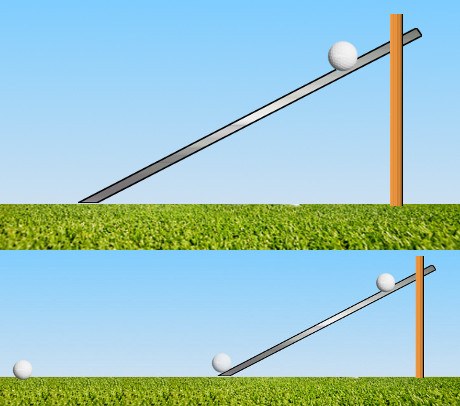You're Correct!

When tournament officials wish to measure the speed of a green they use a device and scale known as the Stimpmeter – which has a rather curious history!
It works by rolling a ball off a metal bar and measuring the distance it travels in feet. The force applied to the ball is constant and can be applied on flat lies as well as sloping lies. The measurement on sloping lies even uses a formula borrowed from Isaac Newton!
The Stimpmeter was invented by an accomplished amateur golfer and Harvard Golf Team Captain, Edward S. Stimpson, Sr. in 1935. Stimpson decided to invent a device to measure the speed of greens after spectating at the 1935 U.S. Open at Oakmont. Whilst there, he watched Gene Sarazen putt a ball off a green and was convinced they were almost unplayable (to back up his point, the winning score that year was +11 over by Sam Parks Jr).
The device that Stimpson designed was made of wood and became known as the Stimpmeter. It consisted of an angled track down which the ball is released at a known speed. After it stops rolling, the distance is measured against the ball’s velocity and a “Stimp” reading is produced. More modern day Stimpmeters’ have been produced made of aluminium and are manufactured to precise specifications.
Stimpmeter readings allow tournament organisers to assess if greens are becoming too fast or too slow. Experienced tour professionals can also use the readings when assessing what shots to hit and which parts of the green to avoid.
Greens during tournament play on the world elite tours are measured using the Stimpmeter which gives consistent results and allows organisers to tell if they have shaved a little too much grass from the surface!
Sorry Try Again! - See Explanation Below
Because official USGA and R&A Stimpmeters are not sold to the public, it is unlikely your golf club or competition committee will have access to one. This means that any Stimp readings are likely to be estimates and best ignored.
Sorry Try Again! - See Explanation Below
Like all scientific measurements, the speed of putting greens is best left to a piece of consistent machinery. Players’ opinions can be subjective and open to interpretation and contradiction.
Sorry Try Again! - See Explanation Below
Although a ball is used in the measurement of green speed, a putter is definitely out of the question. This is because balls will leave different putters at different speeds even if the swing length used is the same. If you add in the human error element the problem becomes more acute. Using a device which rolls the ball along the green at a consistent speed will give more accurate results.







